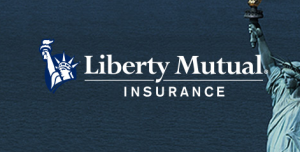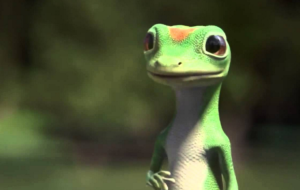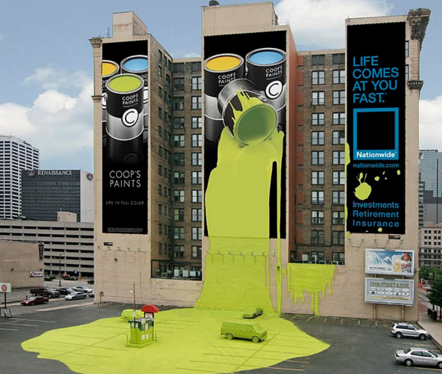Advertising works the way the grass grows? Not in our minds. Check out what’s going on in the insurance advertising war.
But first, let me share a story with you:
Once upon a time, a very strong woodcutter asked for a job with a timber merchant, and he got it. The pay was really good, and so were the work conditions. For that reason, the woodcutter was determined to do his best. His boss gave him an ax and showed him the area where he was supposed to work.
The first day, the woodcutter brought in 18 trees, and of course, his boss congratulated him. Motivated by his boss’s words, the woodcutter tried harder the next day, but he could only bring in 15 trees. On the third day, he tried even harder, but he could only bring in 10 trees. Day after day he was bringing in fewer and fewer trees.
The woodcutter thought he was losing his strength, and he went to the boss and apologized, saying that he couldn’t understand what was going on. His boss then asked, “When was the last time you sharpened your ax?” Appalled by the question, the woodcutter harshly replied, “Sharpen my ax? I have no time to do that. I’ve been busy cutting trees.”
So I pose this question to you: Are you too busy chopping trees on the front line and not allocating the time needed to sharpen your marketing skills? What is that costing you and your business? Furthermore, how much time would it really take to keep your marketing ax sharp?

Check out our thoughts on creative marketing.
Back to the main story: in many ways, you can trace the insurance ad war back to one man — Warren Buffett, who in 1996 made Geico a subsidiary of his Berkshire Hathaway. To this day, Geico Chief Marketing Officer Ted Ward can repeat what Mr. Buffett told him that year. The one thing I don’t want you to have stand in your way is money. That’s what I’ve got.
That moment would launch an onslaught of advertising the likes of which the car-insurance industry had never seen before — filled with pigs, cavemen, googly eyes, and, of course, a little green lizard that was conceived on the back of a napkin and debuted in ads in 2000. Geico’s advertising strategy propelled the insurer to yearly market-share gains and forcing competitors to step up their game. Insurer after insurer is now hitting the airwaves with character-driven campaigns, from “Mayhem” to State Farm’s “magic jingle” to Nationwide’s “Greatest Spokesperson.”
Do you ever see an insurance commercial that you liked and watched it? Can you remember the brand? We would love to hear what it was. Would you do us a favor and tell us in the comments section? It would be greatly appreciated by our readers and us.
And who doesn’t remember those jingles? “Nationwide is on your side” and “You’re in good hands with Allstate” can be accurately sung by almost anyone who watches television. You’re probably singing one of these jingles right now. All of this smart and pervasive advertising leads to a few questions: How much does all of this cost? Are your premiums higher because of all the cartoon lizards and cavemen? Do you select an insurance company based on their commercials?
Or has this ad blitz brought in so many new customers and so much new revenue that your policy rates will go down? Not likely, as the competition is to win market share mostly from each other.
Related post: A How-To Guidebook for Creating Winning Advertising
The costs? That is the shocking part. Data provider SNL Financial found Geico had spent about $994 million on advertising in 2011. That was fully 22 percent more than next-largest spender State Farm, even though State Farm’s ad spending grew at nearly three times the rate Geico’s did.
SNL found that Geico’s ad budget represented 6.5 percent of the premiums it wrote in 2011. Wow, 6.5% of its revenue! That’s shocking to us. Among the rest of the five largest auto insurers in the country, none spent more than 4.9 percent of premiums on ads. State Farm spent 1.7 percent of premiums on advertising.
For the whole industry, in fact, the average is just 2.4 percent. [Allstate spent $745 million or 3.0 percent on advertising; Farmers spent $718 million or 4.9 percent, and Progressive paid $536 million or 3.9 percent, according to SNL.]
But is the spending sustainable? And how are insurers differentiating themselves in the crowded market? By these commercials? If so, consumers need to wake up. There are no fewer than 11 major TV campaigns on air … creating lots of consumer confusion?
State Farm, which has 18.6% of the market with premium revenue of $30.5 billion in 2009, and Allstate are fending off pesky challengers Geico and Progressive, while smaller players such as Liberty Mutual and American Family Insurance are seeking attention with very un-Geico-like serious messages.
Behind it all is an important market dynamic: the shift from the traditional insurance agent to do-it-yourself rate shopping hyped by companies like Geico and Progressive that taught millennials, the 76 million people born between 1977 and 1992 increasingly entering the insurance market, to seek quotes online. Some 48% of millennials turn to the web first, according to J.D. Power & Associates’ 2010 Insurance Shopping Study.
The goal is to grab the attention of consumers who would rather not think about insurance. Experts say most people only ponder policies when they have an accident, buy a new car, move, or renew their existing agreement, which usually happens twice a year, at most. Today there are about 187 million insured privately owned vehicles on the road. Turnover is relatively little from year to year — 11% of consumers switch their policies while an additional 20% shop but don’t switch, according to J.D. Power. But that still means more than 20 million people are in the market each year.
The average shopper can name just four insurance brands off the top of their head, according to J.D. Power. But is it going to remain faithful that the way to get on that list is to advertise — all the time?
So let’s review the ad strategy of each of the largest market share holders.
State Farm
State Farm leads the pack in 2012 with 10.3 % of the market. Their strategy is to boost its digital marketing and to roll out a series of humorous TV ads that highlight affordability and service. Some feature Green Bay Packer stars Aaron Rodgers and Clay Matthews and gaping fans. Others feature a sad sack who dumped State Farm for a discounter right before plowing into a utility pole.
To keep its current customers, State Farm spells out how turning to another insurer that looks better on the outside can cause regret—and lets customers know that it’s OK to “let it out.” Tagline points to getting to a better state.

Liberty Mutual
Liberty Mutual had 5.4% of the market in 2012. With so many light-hearted campaigns running, some insurers think the way to break through is to get serious. Liberty Mutual touts car-replacement coverage in an ad, where a car is rear-ended, shattered and then magically put back together as somber piano music plays. Messages show Liberty Mutual understands that accidents happen to even the most responsible people. And pointing out that they are at their best when humans are at their worst.
Insurance advertising war … Allstate
Allstate follows in 2012 with 5.1% of the market. You may know Dean Winters as a television actor, appearing on shows such as 30 Rock. But you know him as “Mayhem” in Allstate’s favorite ad campaign. Mayhem was a unanimous selection for the best commercials.
The 2-year-old Mayhem campaign, with character actor as a cross between Dennis the Menace and a devious frat boy, has been an effective counter to Progressive and Geico’s discount themes. At least a partial concept of claim service?
Travelers
Travelers had 4.4% of the market in 2012. They are taking a more emotional approach to their campaign. Dogs are advertising gold, and Travelers knows it. The company has been featuring an adorable scruffy dog in a series of ads that show how they can cover home and auto and reward customers for “good behavior.” In this particular ad, the Travelers dog falls in love and soon finds he needs more protection than ever before.

Geico
Geico had a 3.9% market share in 2012. Anyone who has watched television in the United States even briefly knows the Geico brand — talking British geckos, erudite cavemen, greasy-haired announcers with mock baritones, all of them mostly running gags used to get the company’s name to stick in peoples’ heads.
Geico has had some advertising campaigns that are loved for their humor by some, and disliked by their frequency and lack of value by others (See our article The Geico Happiness Advertising Series: Most Effecting Advertising?). But who doesn’t know the most famous tagline… 15 minutes can save you 15% or more. What don’t we understand is how a business that pays so much on advertising can be lowest in premiums or even competitive?
Nationwide
Nationwide with 3.3% market share in 2012 uses its campaign featuring “the world’s greatest spokesperson” appearing with a microphone at the side of customers in trouble—echoing the company’s slogan and the commercials’ closing jingle of “Nationwide is on your side.” In this commercial, he is sitting next to a customer in his overturned vehicle, delivering the bad news that the car is most likely totaled. However, he brings some good news and cheerful banter to make light of the situation and make customers feel comfortable and safe with Nationwide on their side.
Progressive
Progressive’s commercial spokesperson “Flo” is admittedly getting old, but the addition of two awkward insurance clerks from a nameless rival company has breathed some life back into their campaign. In 2012 they had a 3.2% market share. The lying rivals—who are called out for claiming they offer a service that is only available from Progressive—send customers the message that they should stick with a company they trust, or else they could end up losing their “pantaloons.”
While Flo is designed to close the deal with consumers who are already in the market, Progressive’s new character, called the Messenger, is meant to get more people thinking about insurance. In ads, the mustachioed, leather-jacket-wearing pitch man sneaks up on customers, pushing them on discounts.
A smarter way to shop around … now that’s progressive.
Insurance advertising war … USAA
Another competitor, USAA Group, has rolled out its first-ever national marketing campaign, which Vice President of Marketing Chris Owen credit’s for the carrier’s 8% jump in market share last year, at 2.6%. USAA caters to military personnel, veterans, and their families, so USAA Group eschewed humor for six TV spots featuring customers. The key message is the legacy of the company in its service to the military … passed down from generation to generation. Bringing peace of mind in claims and service in your times of need.
Much of the marketing and jawboning may make little difference in the long run. While consumers may be shopping around more, Bob Hartwig, president of the Insurance Information Institute trade group, says only about one in 10 drivers switch policies, a level that’s been consistent for a decade — even with the big ad push. The so-called retention rate during the recession didn’t change much. Rather than switch carriers, many cuts cost by raising their deductibles or dropping coverage.
The bottom line
The experience should match the customer’s expectations. For example, a customer’s expectations will be different for a roadside hotel versus a full-service luxury hotel like the Four Seasons. That smaller, roadside hotel may have a brand promise that includes a clean room and friendly service. The Four Seasons promises much more with a luxury experience. Both of them are making a commitment to you in the form of their brand promise. By keeping the brand promise, they meet the expectation.
What will have to change is the marketing mindset. The fundamental questions in the coming years will not be how to deploy this or that new technology, but how to can solve fundamental marketing problems, such as how to earn consumers’ trust and how to create experiences that are more impactful, useful, productive, and beneficial.

So how do you select your insurance company? Does thinking about the commercials, their messages, and costs make you rethink your decision? It certainly does for us.
All you get is what you bring to the fight. And that fight gets better every day you learn and apply new ideas.
When things are not what you want them to be, what’s most important is your next step.
Test. Learn. Improve. Repeat.
Are you devoting enough energy to improving your advertising design?
Do you have a lesson about making your innovation better you can share with this community? Have any questions or comments to add in the section below?
Digital Spark Marketing will stretch your thinking and your ability to adapt to change. We also provide some fun and inspiration along the way.
More reading on advertising from Digital Spark Marketing’s Library:
What to Expect from a Creative Advertising Strategy
Creative Secrets from Budweiser Advertising Examples
Prudential Ad Makes Visualization Design Central to Story
Ten Deadly Sins of Advertising Design
